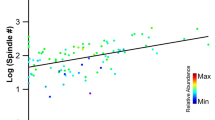Abstract
Fibre bundles or whole muscles from Xenopus laevis, ranging in size from 0.5-60g, were studied. Maximum power output of predominantly fast (sartorius) and slow (adductor magnus) muscles was measured at cycle frequencies between 0.5 and 20Hz, using the work loop technique. Power output was highly dependent on cycle frequency, and in 50-60g adults was maximal at 6 Hz for fast fibres (65 Wkg-1), and 2 Hz for slow fibres (14 Wkg-1). The cycle frequency for maximum power output was dependent on body mass (M b), and decreased as a function of M b -0.07 in fast fibres, and M b -0.23 in slow fibres. The functional significance of these differences is discussed.
Similar content being viewed by others
Author information
Authors and Affiliations
Corresponding author
Rights and permissions
About this article
Cite this article
Altringham, J.D., Morris, T., James, R.S. et al. Scaling effects on muscle function in fast and slow muscles of Xenopus laevis . EBO 1, 1–8 (1996). https://doi.org/10.1007/s00898-996-0006-z
Received:
Accepted:
Published:
Issue Date:
DOI: https://doi.org/10.1007/s00898-996-0006-z




